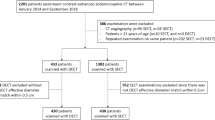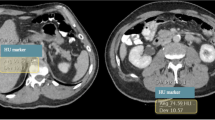Abstract
Purpose
To standardize workflow for dual-energy computed tomography (DECT) involving common abdominopelvic exam protocols.
Materials and methods
9 institutions (4 rsDECT, 1 dsDECT, 4 both) with 32 participants [average # years (range) in practice and DECT experience, 12.3 (1–35) and 4.6 (1–14), respectively] filled out a single survey (n = 9). A five-point agreement scale (0, 1, 2, 3, 4—contra-, not, mildly, moderately, strongly indicated, respectively) and utilization scale (0—not performing and shouldn’t; 1—performing but not clinically useful; 2—performing but not sure if clinically useful; 3—not performing it but would like to; 4—performing and clinically useful) were used. Consensus was considered with a score of ≥2.5. Survey results were discussed over three separate live webinar sessions.
Results
5/9 (56%) institutions exclude large patients from DECT. 2 (40%) use weight, 2 (40%) use transverse dimension, and 1 (20%) uses both. 7/9 (78%) use 50 keV for low and 70 keV for medium monochromatic reconstructed images. DECT is indicated for dual liver [agreement score (AS) 3.78; utilization score (US) 3.22] and dual pancreas in the arterial phase (AS 3.78; US 3.11), mesenteric ischemia/gastrointestinal bleeding in both the arterial and venous phases (AS 2.89; US 2.79), RCC exams in the arterial phase (AS 3.33; US 2.78), and CT urography in the nephrographic phase (AS 3.11; US 2.89). DECT for renal stone and certain single-phase exams is indicated (AS 3.00).
Conclusions
DECT is indicated during the arterial phase for multiphasic abdominal exams, nephrographic phase for CTU, and for certain single-phase and renal stone exams.








Similar content being viewed by others
References
Marin D, Boll DT, Mileto A, Nelson RC (2014) State of the art: dual-energy CT of the abdomen. Radiology 271:327–342
Megibow AJ, Sahani D (2012) Best practice: implementation and use of abdominal dual-energy CT in routine patient care. AJR Am J Roentgenol 199:S71–77
Coursey CA, Nelson RC, Boll DT, et al. (2010) Dual-energy multidetector CT: how does it work, what can it tell us, and when can we use it in abdominopelvic imaging? Radiographics 30:1037–1055
Heye T, Nelson RC, Ho LM, Marin D, Boll DT (2012) Dual-energy CT applications in the abdomen. AJR Am J Roentgenol 199:S64–70
Agrawal MD, Pinho DF, Kulkarni NM, et al. (2014) Oncologic applications of dual-energy CT in the abdomen. Radiographics 34:589–612
Chandarana H, Megibow AJ, Cohen BA, et al. (2011) Iodine quantification with dual-energy CT: phantom study and preliminary experience with renal masses. AJR Am J Roentgenol 196:W693–700
De Cecco CN, Darnell A, Rengo M, et al. (2012) Dual-energy CT: oncologic applications. AJR Am J Roentgenol 199:S98–S105
Graser A, Johnson TR, Chandarana H, Macari M (2009) Dual energy CT: preliminary observations and potential clinical applications in the abdomen. Eur Radiol 19:13–23
Gupta RT, Ho LM, Marin D, et al. (2010) Dual-energy CT for characterization of adrenal nodules: initial experience. AJR Am J Roentgenol 194:1479–1483
Johnson TR, Krauss B, Sedlmair M, et al. (2007) Material differentiation by dual energy CT: initial experience. Eur Radiol 17:1510–1517
Kaza RK, Platt JF, Cohan RH, et al. (2012) Dual-energy CT with single- and dual-source scanners: current applications in evaluating the genitourinary tract. Radiographics 32:353–369
Silva AC, Morse BG, Hara AK, et al. (2011) Dual-energy (spectral) CT: applications in abdominal imaging. Radiographics 31:1031–1046 ((discussion 1047–1050))
Vrtiska TJ, Takahashi N, Fletcher JG, et al. (2010) Genitourinary applications of dual-energy CT. AJR Am J Roentgenol 194:1434–1442
Yeh BM, Shepherd JA, Wang ZJ, et al. (2009) Dual-energy and low-kVp CT in the abdomen. AJR Am J Roentgenol 193:47–54
Yu L, Leng S, McCollough CH (2012) Dual-energy CT-based monochromatic imaging. AJR Am J Roentgenol 199:S9–S15
Patel BN, Thomas JV, Lockhart ME, Berland LL, Morgan DE (2013) Single-source dual-energy spectral multidetector CT of pancreatic adenocarcinoma: optimization of energy level viewing significantly increases lesion contrast. Clin Radiol 68:148–154
Shuman WP, Green DE, Busey JM, et al. (2014) Dual-energy liver CT: effect of monochromatic imaging on lesion detection, conspicuity, and contrast-to-noise ratio of hypervascular lesions on late arterial phase. AJR Am J Roentgenol 203:601–606
Macari M, Spieler B, Kim D, et al. (2010) Dual-source dual-energy MDCT of pancreatic adenocarcinoma: initial observations with data generated at 80 kVp and at simulated weighted-average 120 kVp. AJR Am J Roentgenol 194:W27–32
Carrascosa P, Leipsic JA, Capunay C, et al. (2015) Monochromatic image reconstruction by dual energy imaging allows half iodine load computed tomography coronary angiography. Eur J Radiol 84:1915–1920
Chai Y, Xing J, Gao J, et al. (2016) Feasibility of virtual nonenhanced images derived from single-source fast kVp-switching dual-energy CT in evaluating gastric tumors. Eur J Radiol 85:366–372
Sun H, Hou XY, Xue HD, et al. (2015) Dual-source dual-energy CT angiography with virtual non-enhanced images and iodine map for active gastrointestinal bleeding: image quality, radiation dose and diagnostic performance. Eur J Radiol 84:884–891
Yamada Y, Jinzaki M, Hosokawa T, et al. (2014) Abdominal CT: an intra-individual comparison between virtual monochromatic spectral and polychromatic 120-kVp images obtained during the same examination. Eur J Radiol 83:1715–1722
Tawfik AM, Kerl JM, Razek AA, et al. (2011) Image quality and radiation dose of dual-energy CT of the head and neck compared with a standard 120-kVp acquisition. AJNR Am J Neuroradiol 32:1994–1999
Stiller W, Schwarzwaelder CB, Sommer CM, et al. (2012) Dual-energy, standard and low-kVp contrast-enhanced CT-cholangiography: a comparative analysis of image quality and radiation exposure. Eur J Radiol 81:1405–1412
Sommer CM, Schwarzwaelder CB, Stiller W, et al. (2012) Iodine removal in intravenous dual-energy CT-cholangiography: is virtual non-enhanced imaging effective to replace true non-enhanced imaging? Eur J Radiol 81:692–699
Ho LM, Yoshizumi TT, Hurwitz LM, et al. (2009) Dual energy versus single energy MDCT: measurement of radiation dose using adult abdominal imaging protocols. Acad Radiol 16:1400–1407
Pinho DF, Kulkarni NM, Krishnaraj A, Kalva SP, Sahani DV (2013) Initial experience with single-source dual-energy CT abdominal angiography and comparison with single-energy CT angiography: image quality, enhancement, diagnosis and radiation dose. Eur Radiol 23:351–359
Ma CL, Chen XX, Lei YX, et al. (2016) Clinical value of dual-energy spectral imaging with adaptive statistical iterative reconstruction for reducing contrast medium dose in CT portal venography: in comparison with standard 120-kVp imaging protocol. Br J Radiol 89:20151022
Yu L, Christner JA, Leng S, et al. (2011) Virtual monochromatic imaging in dual-source dual-energy CT: radiation dose and image quality. Med Phys 38:6371–6379
Marin D, Ramirez-Giraldo JC, Gupta S, et al. (2016) Effect of a noise-optimized second-generation monoenergetic algorithm on image noise and conspicuity of hypervascular liver tumors: an in vitro and in vivo study. AJR Am J Roentgenol 206:1222–1232
Guimaraes LS, Fletcher JG, Harmsen WS, et al. (2010) Appropriate patient selection at abdominal dual-energy CT using 80 kV: relationship between patient size, image noise, and image quality. Radiology 257:732–742
Mileto A, Nelson RC, Samei E, et al. (2014) Dual-energy MDCT in hypervascular liver tumors: effect of body size on selection of the optimal monochromatic energy level. AJR Am J Roentgenol 203:1257–1264
Leng S, Huang A, Cardona JM, Duan X, Williams JC, McCollough CH (2016) Dual-energy CT for quantification of urinary stone composition in mixed stones: a phantom study. AJR Am J Roentgenol: 1–9
Marin D, Pratts-Emanuelli JJ, Mileto A, et al. (2015) Interdependencies of acquisition, detection, and reconstruction techniques on the accuracy of iodine quantification in varying patient sizes employing dual-energy CT. Eur Radiol 25:679–686
Mileto A, Nelson RC, Samei E, et al. (2014) Impact of dual-energy multi-detector row CT with virtual monochromatic imaging on renal cyst pseudoenhancement: in vitro and in vivo study. Radiology 272:767–776
Ascenti G, Sofia C, Mazziotti S, et al. (2016) Dual-energy CT with iodine quantification in distinguishing between bland and neoplastic portal vein thrombosis in patients with hepatocellular carcinoma. Clin Radiol
Lee JA, Jeong WK, Kim Y, et al. (2013) Dual-energy CT to detect recurrent HCC after TACE: initial experience of color-coded iodine CT imaging. Eur J Radiol 82:569–576
Pietryga JA, Morgan DE (2015) Imaging preoperatively for pancreatic adenocarcinoma. J Gastrointest Oncol 6:343–357
Lin XZ, Wu ZY, Tao R, et al. (2012) Dual energy spectral CT imaging of insulinoma-value in preoperative diagnosis compared with conventional multi-detector CT. Eur J Radiol 81:2487–2494
Sun H, Xue HD, Wang YN, et al. (2013) Dual-source dual-energy computed tomography angiography for active gastrointestinal bleeding: a preliminary study. Clin Radiol 68:139–147
Potretzke TA, Brace CL, Lubner MG, et al. (2015) Early small-bowel ischemia: dual-energy CT improves conspicuity compared with conventional CT in a swine model. Radiology 275:119–126
Darras KE, McLaughlin PD, Kang H, et al. (2016) Virtual monoenergetic reconstruction of contrast-enhanced dual energy CT at 70 keV maximizes mural enhancement in acute small bowel obstruction. Eur J Radiol 85:950–956
Mileto A, Sofue K, Marin D (2016) Imaging the renal lesion with dual-energy multidetector CT and multi-energy applications in clinical practice: what can it truly do for you? Eur Radiol 26:3677
Mileto A, Marin D, Alfaro-Cordoba M, et al. (2014) Iodine quantification to distinguish clear cell from papillary renal cell carcinoma at dual-energy multidetector CT: a multireader diagnostic performance study. Radiology 273:813–820
Chow LC, Kwan SW, Olcott EW, Sommer G (2007) Split-bolus MDCT urography with synchronous nephrographic and excretory phase enhancement. AJR Am J Roentgenol 189:314–322
Maheshwari E, O’Malley ME, Ghai S, Staunton M, Massey C (2010) Split-bolus MDCT urography: upper tract opacification and performance for upper tract tumors in patients with hematuria. AJR Am J Roentgenol 194:453–458
Brown CL, Hartman RP, Dzyubak OP, et al. (2009) Dual-energy CT iodine overlay technique for characterization of renal masses as cyst or solid: a phantom feasibility study. Eur Radiol 19:1289–1295
Graser A, Johnson TR, Hecht EM, et al. (2009) Dual-energy CT in patients suspected of having renal masses: can virtual nonenhanced images replace true nonenhanced images? Radiology 252:433–440
Neville AM, Gupta RT, Miller CM, et al. (2011) Detection of renal lesion enhancement with dual-energy multidetector CT. Radiology 259:173–183
Song KD, Kim CK, Park BK, Kim B (2011) Utility of iodine overlay technique and virtual unenhanced images for the characterization of renal masses by dual-energy CT. AJR Am J Roentgenol 197:W1076–1082
Karlo CA, Gnannt R, Winklehner A, et al. (2013) Split-bolus dual-energy CT urography: protocol optimization and diagnostic performance for the detection of urinary stones. Abdom Imaging 38:1136–1143
Moon JW, Park BK, Kim CK, Park SY (2012) Evaluation of virtual unenhanced CT obtained from dual-energy CT urography for detecting urinary stones. Br J Radiol 85:e176–181
Kaza RK, Platt JF (2016) Renal applications of dual-energy CT. Abdom Radiol (NY) 41:1122–1132
Graser A, Johnson TR, Bader M, et al. (2008) Dual energy CT characterization of urinary calculi: initial in vitro and clinical experience. Investig Radiol 43:112–119
Bres-Niewada E, Dybowski B, Radziszewski P (2014) Predicting stone composition before treatment: can it really drive clinical decisions? Cent Eur J Urol 67:392–396
Author information
Authors and Affiliations
Corresponding author
Ethics declarations
Funding
No funding was received for this study.
Conflict of interest
Bhavik N. Patel, Lauren Alexander, Brian Allen, Lincoln Berland, Amir Borhani, Courtney Moreno, Mitchell Tublin: no relevant financial disclosures; D. Morgan: research support, General Electric Healthcare; Dushyant Sahani: medical consultant and research support, General Electric Healthcare; royalties from Elsevier; William Shuman: research support, General Electric Healthcare; Eric Tamm: research support, General Electric Healthcare; Benjamin Yeh: research support from General Electric Healthcare; shareholder for Nextrast, Inc; royalties from Oxford University Press. D. Marin: research support, Siemens Healthcare. One of the authors (B.P.), who is neither an employee or consultant to industry, had control of the data and the information submitted for publication.
Ethical approval
This article does not contain any studies with human participants or animals performed by any of the authors.
Informed consent
Statement of informed consent was not applicable since the manuscript does not contain any patient data.
Rights and permissions
About this article
Cite this article
Patel, B.N., Alexander, L., Allen, B. et al. Dual-energy CT workflow: multi-institutional consensus on standardization of abdominopelvic MDCT protocols. Abdom Radiol 42, 676–687 (2017). https://doi.org/10.1007/s00261-016-0966-6
Published:
Issue Date:
DOI: https://doi.org/10.1007/s00261-016-0966-6




